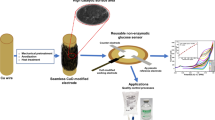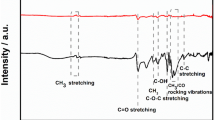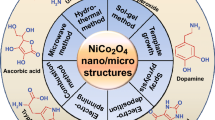Abstract
Herein, a carbon paste electrode was modified with 2,4-dinitrophenylhydrazine (2,4-DNPHMCPE), for the first time, to sense the three amino acids including glycine, aspartic acid, and glutamic acid. The newly developed 2,4-DNPHCPE presented sensitive electrocatalytic behavior toward amino acids as compared to the unmodified carbon paste electrode under optimized conditions. The maximum value oxidation peak current was obtained at a concentration of 0.6 × 10–4 M in phosphate buffer saline solution of pH 7.4. The analytical response was achieved for glycine, glutamic acid, and aspartic acid at + 0.8 V, + 0.6 V, + 0.5 V, respectively, at a scan rate of 0.005 V/s. In several scans, the absence of a reduction peak revealed that the mechanism was irreversible. Furthermore, 2,4-DNPHMCPE showed a linear relationship between the amino acids’ concentration and their anodic peak current values range from 0.1 × 10–4 to 0.6 × 10–4 M with the limit of detection 0.4 × 10–5 M (S/N = 3). Optimization of scan rate unveiled that the electrode process was under diffusion control. The involvement of protons and electrons in the amino acids’ oxidation was observed to be equivalent, which in turn proved that the modified electrode possessed good precision and accuracy. In conclusion, the 2,4-DNPHMCPE-based electrochemical sensing method is a low cost and can be used for the sensitive detection of amino acids.
Graphic abstract






Similar content being viewed by others
References
Castro SS, Mortimer RJ, De Oliveira MF, Stradiotto NR (2008) Sensors 8:1950
Mazloum-Ardakani M, Sabaghian F, Khoshroo A, Abolhasani M, Naeimi H (2015) Ionics 21:239
McCreery RL, Dreiling R, Adams RN (1974) Brain Res 73:15
Meldrum BS (1007S) J Nutr 130:1007S
McEntee WJ, Crook TH (1993) Psychopharmacology 111:391
Haroon E, Miller AH, Sanacora G (2017) Neuropsychopharmacology 42:193
Okubo Y, Sekiya H, Namiki S, Sakamoto H, Iinuma S, Yamasaki M, Watanabe M, Hirose K, Iino M (2010) Proc Natl Acad Sci 107:6526
Chen PE, Geballe MT, Stansfeld PJ, Johnston AR, Yuan H, Jacob AL, Snyder JP, Traynelis SF, Wyllie DJ (2005) Mol Pharmacol 67:1470
El-Naggar T, Carretero ME, Arce C, Gómez-Serranillos MP (2017) Pharm Biol 55:1415
Ripps H, Shen W (2012) Mol Vis 18:2673
Liu Y, Zhang J (2000) Chin Med J 113:948
Li X, Li W, Reed DR, Bachmanov AA, Brand JG (2012) Taste receptors of the T1R family from domestic cat and their uses. U.S. Patent 7,527,944, May 5, 2009; (2005) Chem Abstr 142:131527
Chandrashekar B, Swamy BK, Pandurangachar M, Shankar SS, Gilbert O, Manjunatha J, Sherigara B (2010) Int J Electrochem Sci 5:578
Castro SS, Mortimer RJ, De Oliveira MF, Stradiotto NR (2008) Sensors (Basel) 8:1950
Gilbert O, Swamy BK, Chandra U, Sherigara B (2009) Int J Electrochem Sci 4:582
Rahbar N, Parham H (2013) Jundishapur J Nat Pharm Prod 8:118
Naik RR, Swamy BK, Chandra U, Niranjana E, Sherigara B, Jayadevappa H (2009) Int J Electrochem Sci 4:855
Oliveira PR, Lamy-Mendes AC, Rezende EI, Mangrich AS, Marcolino LH Jr, Bergamini MF (2015) Food Chem 171:426
Karimi-Maleh H, Shojaei M, Amini F, Akbari A (2017) Electroanalysis 29:1854
Jerković A, Abou-Ahmed S, Ertl P, Stoeßl B, Lengauer V, Samphao A, Kalcher K, Leitinger G, Wernitznig S, Ortner A (2018) Anal Chim Acta 1038:52
Naik TSK, Swamy BK (2017) J Electroanal Chem 804:78
Munoz J, Baeza M (2017) Electroanalysis 29:1660
Chandra U, Kumara Swamy B, Gilbert O, Shankar SS, Mahanthesha K, Sherigara B (2010) Int J Electrochem Sci 5:1
Lopa NS, Rahman MM, Jang H, Sutradhar SC, Ahmed F, Ryu T, Kim W (2017) Microchim Acta 185:23
Jackowska K, Krysinski P (2013) Anal Bioanal Chem 405:3753
Acknowledgements
This work was financially supported by the Institute of Chemical Sciences, Bahuddin Zakariya University Multan, and Higher Education Commission (HEC) of Pakistan.
Author information
Authors and Affiliations
Corresponding authors
Additional information
Publisher's Note
Springer Nature remains neutral with regard to jurisdictional claims in published maps and institutional affiliations.
Rights and permissions
About this article
Cite this article
Nawaz, R., Rasheed, T., Iqbal, T. et al. Development of 2,4-dinitrophenylhydrazine-modified carbon paste electrode for highly sensitive electrochemical sensing of amino acids. Monatsh Chem 151, 505–510 (2020). https://doi.org/10.1007/s00706-020-02580-y
Received:
Accepted:
Published:
Issue Date:
DOI: https://doi.org/10.1007/s00706-020-02580-y




